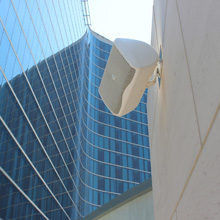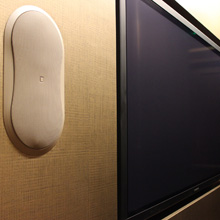 |
| Praesideo digital emergency sound system was used to distribute public address capabilities throughout the facility |
For sheer complexity there are few sound installations that compete with a large convention/resort hotel. Combining massive scale, a multitude of paging zones, and a huge variety of sonic environments—meeting rooms, restaurants, clubs, spas, pools, lobbies—a destination hotel requires extensive planning and high-level expertise at every stage of design and installation. That’s why Walker Engineering, Inc. of Irving, Texas was selected to handle all electrical, AV, IT, and sound for the new 1001-room Omni Dallas Convention Center Hotel. Drawing on its hotel experience for marquee brands such as Ritz-Carlton, W, and Marriott, Walker had a record of proven performance on complex high-profile projects. In turn, Walker demanded the same qualities of its own vendors on the project, and selected Bosch and Electro-Voice as suppliers of the vast majority of the hotel’s installed sound system.
Opened in late 2011, the Dallas Omni was conceived as the perfect complement to the Dallas Convention Center, to which it is connected via a Sky Bridge. The $500 million building is owned by the City of Dallas and operated by Omni Hotels & Resorts of Irving. It was designed by Dallas architects BOKA Powell with engineering by Blum Consulting Engineers, and built by general contractor Balfour Beatty Construction.
Capable of hosting events of more than 3,300 attendees, the Dallas Omni contains extensive meeting facilities to supplement those of the convention center itself. 110,000 square feet of total meeting space is available across 21 meeting rooms, the largest of which are the Grand and Junior ballrooms at 32,000 and 15,000 square feet respectively. Boasting LEED Silver certification from the U.S. Green Building Council, the facility also includes four eating places, a gift shop, a Mokara Spa, a fitness center overlooking downtown Dallas, and a rooftop terrace with an endless pool.
The AV lead on the project was Walker Engineering’s audio, video, lighting, network, and security specialist Kip Kendrick. “We were involved from the beginning on this project,” Kendrick says, “providing design, development, and installation services for all electrical systems, from high voltage all the way down to low voltage AV security and network.”
Kendrick says that the hotel’s central location and close association with the convention center meant that its installed systems had to be capable of more than simple background music and meeting PA. “It is a convention hotel, and likely to be involved in political events, public presentations, and other events that would involve quantities of people and require high-level security and extensive communication with the occupants. The hotel needs public address functionality during events, notification capabilities for safety and security, and to communicate basic data and emergency data, not just music, across the hotel public spaces.”
To distribute public address capabilities throughout the facility while maintaining fine control over a multitude of discrete zones, Walker settled on the Praesideo digital public address and emergency sound system from Bosch. “Because of the size of this hotel,” Kendrick says, “our first concern was finding a system that could communicate at a rapid pace across a large facility. Praesideo is built on a fiber-optic platform. It runs on its own fiber loop, and it maintains its own fiber network protocol. All of which allows it to be connected in a large facility without requiring burdensome network protocols. By establishing Praesideo as the backbone of our audio transport inside the facility, we are able to push 28 simultaneous audio paths throughout the building with near-zero latency.”
Beyond the backbone
 |
| The hotel needed public address functionality during events, notification capabilities for safety and security |
More than just a network backbone, Praesideo is a complete integrated solution that mates user-friendly software control with an array of hardware components built around an intelligent network controller, the LBB 4401/00, that is accessed via an Ethernet-connected PC. Audio components include audio I/O expanders, call stations, and power amplifiers. Network components include CobraNet interfaces, branching splitters, and fiber interfaces. By combining a relatively simple collection of components, designers are able to create Praesideo systems that are extraordinarily fast over very large cable distances.
When used in full redundant loop design, Praesideo (version 3.3 or higher) is certified as an emergency sound system meeting EN54-16 and ISO 7240-16 safety standards. That wasn’t the intent at the Omni, however, where the system is configured in a star topology. “We are not using it as a certified mass notification system,” Kendrick says, “so our topology is not fully redundant. But it has some redundancy, and it includes the system reporting and notification features that are required of a mass notification system.”
In addition to its speed over long runs, Kendrick cites a host of additional features that factored into the selection of Praesideo. One was the ease with which Praesideo covers all of the various forms of audio needed in a hotel and meeting space context. “It handles live announce as well as recorded messages stored on a server,” Kendrick says. “And it is carrying various music content over its architecture, so that in multiple locations within the hotel they have shared audio resources, or each zone can have its own mood-setting music that differentiates it from other zones. You have a whole bunch of different combinations all preconfigured on your PC-based interface, and you just select the one that’s right for what you’re trying to do at that moment.”
To take advantage of Praesideo’s zoning capabilities, Kendrick explains, he was “careful to zone speakers so that they align themselves with meeting-room spaces. A client that’s got a meeting going on may want to hear less music from the hallway, or they may want more music in the hallway outside of their meeting rooms because they’ve got a check-in desk out there. Either way this system can drill down just into the area outside of that meeting room and adjust just those speakers, and not impact someone else on that floor.”
The key to this localised control, Kendrick says, is Praesideo’s processing architecture. “Rather than having a big, centralised rack with all the power, the hotel has a very distributed network. The main NCO handles the software and the user interface, which includes an on-screen representation of the system that allows you to dial into a very defined location and change aspects of the audio there. The NCO also defines the pathway of all audio and control data coming in and out, but the actual manipulation of the audio happens at each channel output of each of the system’s amplifiers. So to Praesideo a zone is a single amplifier channel, and zones can be bundled into groups or controlled individually.” In all the Omni Dallas uses 114 zones.
Kendrick points to this individual control as a major advantage for Praesideo. “Something that would be complicated with a lot of other systems becomes simple with Praesideo. For example, to address speakers in a specific location with an older system design we would typically assign one output to an amplifier and daisy-chain from there, going bridge mono to cover an entire group of speakers. So you could change the gain structure at the amplifier, but you wouldn’t be able to really drill down specifically to a small area to change the musical content, the EQ on it, or its other characteristics.”
The feature that factored the selection of Praesideo was the ease with which it covers all of the various forms of audio needed in a hotel and meeting space context. |
In contrast, Kendrick continues, “Praesideo allows us to EQ just the speakers powered by a given channel, or to delay just that set of speakers, or to adjust the gain structure for just those speakers in that particular location. All of this without causing processing burden on the rest of the system. So the architecture of Praesideo gives you detailed control that doesn’t cost more.”
Anything anywhere
Another aspect of Praesideo’s flexibility, Kendrick says, is the fact that “Praesideo, in its architecture, doesn’t care where anything is, as long as it’s connected. Anything can be anywhere on the system.” Perhaps the most obvious example of this is that every amplifier chassis also co-houses an input panel, but those inputs are independent of the amp in that chassis. As a result, content originating anywhere can be routed anywhere else.
“You’re not locked into sources having to be local,” Kendrick says. “You can plug something—a CD player, for instance—into the closest local input, and once it’s there on the internal buss of the Praesideo system, you can send the signal throughout the entire building or assign it to any individual area of the building. It’s the ultimate in routing.”
This same routing versatility also allows sources to be used locally without losing centralized control. “A case in point at the hotel,” Kendrik explains, “is in the hotel spa’s treatment rooms, and in the cabanas at the pool. Each cabana, for example, has its own local Praesideo input for an audio source like an MP3 player. When that audio is received by Praesideo, it becomes an available audio path to the amplifier in that cabana. They choose the audio they want to listen to from a little Crestron keypad, and one of their choices will be their own local source. So we’ve taken a local input and routed it to a single local output zone.”
Praesideo’s flexible routing also extends to the system’s paging functions. “The LBD-4432 call stations are equipped with a keypad that allows you to route the microphone signal directly to specific zones set up in the system,” Kendrick explains. “So in a security situation, or in an operator-type situation, an individual can reach up and hit a pre-programmed key and either fire a pre-recorded message that’s delivered to a given area or open up the microphone for live speech.”
As music and announcements are routed out to system’s various zones, the system’s condition is reported back to the NCO. “The amplifiers are intelligent,” Kendrick says, “so if an amp suddenly has a problem, it reports that back to mother ship. And if it just flat-out fails and suddenly doesn’t respond, the mother ship alerts the human operator to the problem. So you have that feedback, and if something goes wrong, you know exactly what went wrong.”
The system also keeps a record of all changes to settings, allowing operators to look for correlations between settings and system performance. “It logs everything that’s going on,” Kendrick says. “So if somebody gives it a command to turn up the volume, we know who, when, and where that command was given. Which is wonderful in a facility like a hotel or a hospital, where you might have a large staff that has access to the system. That can be a big help to a servicer when the client thinks there is something wrong with the system and the problem is actually human error.”
On top of all these features, another Praesideo selling point for Kendrick was the system’s overall efficiency in terms of both cost and energy. “In a very large system, the cost effectiveness of the Praesideo is amazing,” he says. “You don’t need multiples of everything, because everything’s distributed so that as you grow your system, the system naturally builds on itself. And the Bosch amplifiers are very economical to operate. That was another thing that was key for me. They do not generate a ton of heat, and they are very efficient with delivery of watts to the speakers.” The LLB series amplifiers come in one-, two-, four-, and eight-channel configurations.
Exceptional quality
Complementing all of Praesideo’s operational advantages is the clarity of the system’s digital audio transport over interference-free fiber. “The quality of the communication is unheard of,” Kendrick says. “It is exceptional, because the quality of the audio file, right up until it comes out of that speaker, is so high, and so clean. We’ve installed Praesideo in a lot of facilities, including some that had really bad sound that everyone thought was due to the speakers, only find that the speakers sounded fine when we connected the Praesideo system. Praesideo just does a great job of delivering that content. And of course the better the speaker you put it with, the more natural-sounding your system will be, almost as if the person is speaking right next to you. It is just an amazing system.”
For speakers at the Omni Dallas, Walker recommended ceiling, surface-mount, and portable loudspeakers from Electro-Voice, a Bosch company since 2006. “First of all, it makes sense to put products from these two brands together,” Kendrick says, “because they are designed to work really well with one another. But the number-one factor was that the quality was right for this kind of high-level property, and the cost was right for a hotel of this size. You have to take into account the cost when you’re dealing with hundreds of speakers. So we looked at the spectrum of options from various manufacturers, and the cost associated with each, and EV’s EVID line rose to the top in all categories of our quality-vs.-cost matrix. EVIDs are very well-made speakers, they perform well for the client, and our clients are very pleased with the outcome.”
More than 400 of the EVIDs were either C8.2s or C8.2HCs, both of which are 8-inch two-way coaxial ceiling models. “We have varying ceiling heights in this facility,” Kendrick says. “On one of the floors they actually undulate; it goes up really high and then it dips back down and then it goes back to high. So we had to find a way to balance ceiling height and speaker placement, and one of the ways we did that is to use both the normal and high-ceiling versions of the 8.2. They both use the same tweeter and cone, so they give a similar sound to the audio. By standardizing to the 8.2s, we got even dispersion, even where the ceiling jumps really high.”
Kendrick says he has pushed the ceiling system hard and it has come through with flying colors. “Once we got it tuned up and balanced, I began looking for the upper limit. I was running good-quality music—Diane Krall, the Eagles, Sting—across the system, and the sound stayed stable and consistent, so as you walked from zone to zone, you didn’t feel big changes. So the EVIDs have good, even dispersion. And I was able to get up in the neighborhood of 93 dB with no distortion.”
Another sizeable batch of speakers were EVID 6.2 and 4.2 two-way surface-mount loudspeakers, which were used in such places as the poolside cabanas and the pool bar. A flush mount version, the EVID FM 4.2, was used for the reference speakers to the left and right of large displays in the various meeting rooms, as well as for surround-sound systems in the hotel’s three Presidential Suites. The EVID C10.1 high-power ceiling subwoofer, meanwhile, was used to give a fuller sound in the ballrooms and the pre-function spaces outside of the ballrooms.
Additional EV loudspeakers at the property include ZX1i two-way full-range indoor/outdoor loudspeakers deployed in outside areas. “The pool deck has an elevated area that was designed so that they could bring a band out there,” Kendrick says. “We mounted a pair of ZX1is high on that area’s stone wall for pool-deck parties. And if you’re in the pool, you’re hearing another ZX1i. The ZX1is just sound phenomenal. They’ve got good, rich low end, plenty of high end, and good dispersion.”
With excellent sound and exceptional control, the combined Bosch/EV system at the Omni Dallas has proven to be even better than anticipated. “First there is the ability to remotely diagnose the system and make changes,” Kendrick says. “That proved invaluable to me during the hotel’s initial week of operation, because when you actually get people into the space, you naturally need to make adjustments to your assumptions. To be able to do that from my iPad while in a completely different city was spectacular. Ultimately it’s about keeping the client happy, and Praesideo gives you that kind of power. Everything has been received very well, and the system continues to perform over and above expectations.”




